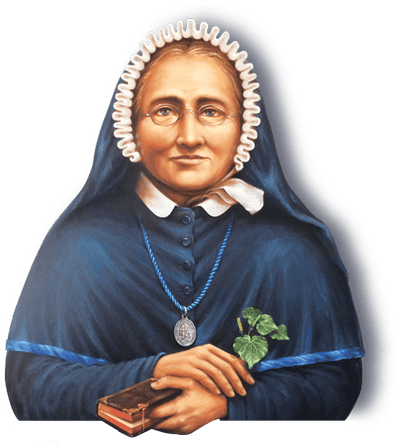
Venerable Suzanne Aubert
Already recognised by the Church as a holy woman, we hope and pray that Venerable Suzanne – Meri Hohepa – Mother Mary Joseph Aubert, will soon be beatified and canonised as Aotearoa-New Zealand’s first saint. Her response to the difficult circumstances of her own time makes her a model and example for us as we grapple with the terrible consequences of a global pandemic. Believing that “in death life is changed, not ended”, we ask her to be with us as we pray to our healing Lord, Jesus Christ, for guidance in our own difficult circumstances.
A Holy Woman
Our belief in the communion of saints, makes us confident that Suzanne would surely want to walk alongside us during this challenging time of lock-down due to the Coronavirus. Born in France, she bridges the gap between Europe and New Zealand in a very special way.
A Kind Woman – Model for Today
Some years ago historian, Jessie Munro, highlighted Suzanne Aubert’s kindness that is still remembered with respect in Māori oral tradition. In a special way, this virtue makes her a model for us as we speak to respond with kindness to all those we meet during this time of lockdown. Jessie recorded the following from what she had heard from Māori in the Whanganui region:
“Hapai and Puke used to tell us about her riding around on a horse with her medicines. They said: ‘e tino pai, te kuia nei. Kei a ia matauranga te aroha me te tumanako.’ “In her heart,’ they said, ‘were kindness and love’. She always wanted to help the people of the river…
The old people talked about her ‘moving around among the people, getting to know the people and understanding. She wasn’t afraid so I believe, just listening to my great-grandmother…’[1]
A Woman who Experienced Lockdown
Suzanne Aubert knew what it was like to be cut off from the people she loved and cared for here in Aotearoa-New Zealand. With the outbreak of World War 1 in 1914, she was in Rome seeking to gain papal approval for the way of life and mission of the Daughters of Our Lady of Compassion – today the Sisters of Compassion. She was forced to remain in Rome until 1919. Elderly woman (79) though she was, Suzanne’s innate kindness and empathy for the suffering had not diminished with age. She volunteered as a nurse, first to help victims of a severe earthquake in the Abruzzi, then to care for wounded soldiers as a member of the Italian Red Cross. In addition to her care for victims, she would certainly have appreciated the work being done by the medical personnel and others of our own time who are caring with similar dedication for the victims of the Coronavirus.
A Holy and Kind Woman Who Intercedes For Us
Venerable Suzanne, Mother Meri Hohepa, Mother Mary Joseph Aubert.
During your lifetime, you showed kindness for and empathy with the sick, the troubled, those suffering from financial hardship and those who grieved.
You experienced the harsh reality of being separated from loved ones and despite this responded with kindness and generosity to the needs of those who suffered the crippling effects of earthquake and war.
Pray, with us, to Jesus our healing Lord, for the welfare of all those afflicted by Coronavirus here in Aotearoa-New Zealand and throughout the world, and for the safety and welfare of those who care for them in any way.
We make this prayer, strong in our belief that in death life is changed not ended, and that Jesus our Risen Lord will bless us as he alone knows how.
Amen
The life-story of Venerable Suzanne Aubert from her birth in France on 19 June 1835 until her death in Wellington, New Zealand, on 1 October 1926, has been told in Jessie Munro’s classic biography, “The Story of Suzanne Aubert” and her writings are now widely available in a variety of books. If you would like further information you can find it on the a website dedicated to her life and spirituality:
[1] Jessi Munro, Lecture delivered to the “Friends of the Whanganui River” at the Davis Lecture Theatre, Whanganui, 10 September 1998. Published in Whanganui River Annual Magazine, 1998.
